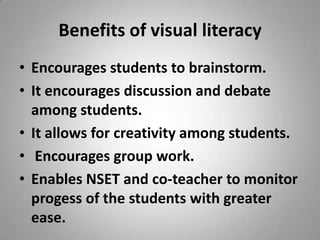
March 26th ppt visual literacy and student centered methods2(mark)
- 1. Benefits of visual literacy Encourages students to brainstorm. It encourages discussion and debate among students. It allows for creativity among students. Encourages group work. Enables NSET and co-teacher to monitor progess of the students with greater ease.
- 2. Creating a picture collage.
- 3. Types of collages. Idioms. Phrasal verbs. Adjectives. Verbs. Nouns. Lesson themes. General knowledge.
- 4. Get on Shut up!!! Break up Take off Break Down Hang up
- 5. Describing items- Demo Lesson. The main aim of this lesson was to develop students ability to describe a specific item for the ‘show and tell’ section of the speaking test. Students were encouraged to work in groups in order to identify shapes, materials, what an item looks like and the uses of specific items. Students were then encouraged to work in groups to describe their own items.
- 6. Describing items- NSET and co-teacher demonstration. It can be brown, green or clear. You can open it. You can close it. It is shaped like a cone. It is used for drinking. It looks like a rocket! It is made from/ out of…….. What am I talking about?
- 8. Students will take note of key vocabulary. It can be used for…. You can (verb) it. It is in the shape of a…. / It is shaped like a.. It can be….. (adjective) It looks like a (noun)
- 11. Final activity- Guess the item Each group will be given a flashcard with a specific item written on it. Students must use the whiteboards to describe the item using the phrases used throughout the lesson. Students will read out their description. The rest of the class will attempt to guess what the item is.
- 12. Speaking Tests for basic classes. 4 Different picture stories. Students also had to answer 4 questions based on the picture story. In the speaking test the student chooses a picture story at random. The students will receive extra marks for additional vocabulary and/or fluency.
- 13. Teaching the picture story. Introduce the theme of the picture story. (e.g: health, sickness, stress etc…) Brainstorm key words form the picture story. NSET tells his own version of the picture story. KT ensures that students comprehend what is being said. Students echo NSET’s instructions. Students attempt their own version of the picture story using the handouts provided. NSET and KT monitor students progress. NSET encourages students to tell the story out loud.
- 15. It is 2am, Mary’s baby is crying. Mary is taking care of her baby. It’s 7am, Mary’s family are hungry. Mary’s family want their breakfast. It’s 8.15am, Mary is late for work. Mary’s boss is angry. It’s 5.15pm, Mary is very tired. Suddenly, Mary crashes her car. It’s 8pm, Mary is very worried. She is looking at her bills. Mary is very stressed.